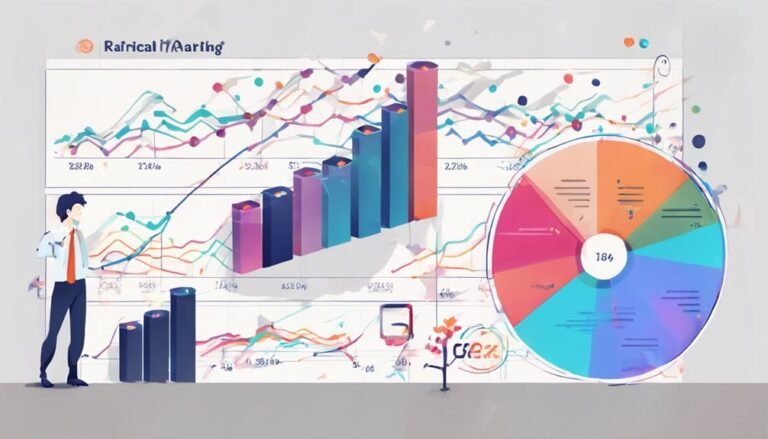What Role Does Customer Segmentation Play in Effective Marketing?
Customer segmentation is vital in effective marketing. By dividing your customer base into distinct groups, you can tailor strategies to target specific segments. Pinpointing the most profitable groups allows for personalized messages, boosting conversion rates. This leads to increased profitability and customer retention. Understanding customer behavior through segmentation provides insights for tailored marketing approaches. By optimizing messages for different segments, you enhance engagement and loyalty. Geographic and demographic targeting helps reach specific audiences effectively. Implementing segmentation strategies aligned with customer needs guarantees maximum impact. Segmentation is key to revealing profitable strategies and enhancing customer relationships.
Key Takeaways
- Tailoring marketing strategies to specific customer groups for increased profitability and personalized communication.
- Understanding customer behavior by delving into preferences, motivations, and decision-making processes.
- Tailoring marketing messages based on customer data for higher conversion rates and satisfaction.
- Enhancing customer engagement through personalized experiences and targeted messaging strategies.
- Improving conversion rates by analyzing behavior, segmenting the audience, and optimizing marketing messages.
Benefits of Customer Segmentation
Segmenting your customers enables you to tailor your marketing strategies more effectively to meet their specific needs and preferences. By dividing your customer base into distinct groups based on characteristics such as demographics, behaviors, or buying patterns, you can achieve increased profitability through more targeted marketing efforts. Effective targeting is essential in maximizing the impact of your marketing campaigns and optimizing your return on investment.
Through customer segmentation, you can pinpoint which customer segments are most profitable for your business and direct your resources towards them. By understanding the unique preferences and behaviors of each segment, you can create personalized marketing messages that resonate with their needs, leading to higher conversion rates and customer retention. This strategic approach allows you to allocate your marketing budget more efficiently, focusing on the segments that offer the greatest potential for growth and profitability. Ultimately, customer segmentation empowers you to build stronger relationships with your customers, driving long-term success for your business.
Understanding Customer Behavior
Understanding customer behavior is a pivotal aspect of marketing strategy, providing valuable insights into the motivations and decision-making processes of your target audience. By delving into customer preferences through thorough market research, you can uncover patterns that inform your marketing tactics. Market research allows you to gather data on consumer behavior, enabling you to anticipate trends and tailor your strategies accordingly.
Analyzing customer behavior helps you understand not just what customers buy, but why they make those choices. This knowledge empowers you to create personalized experiences that resonate with your audience on a deeper level.
Moreover, understanding customer behavior allows you to identify pain points or areas where improvements are needed. This insight can guide product development and marketing campaigns, ensuring that your offerings align with what your customers truly desire. By incorporating customer preferences into your marketing approach, you can enhance customer satisfaction and loyalty, leading to long-term success in the competitive marketplace.
Tailoring Marketing Messages
To effectively tailor marketing messages, consider analyzing customer data to pinpoint specific preferences and behaviors that inform your communication strategies. By leveraging behavioral targeting and understanding customer preferences, you can create personalized and engaging marketing messages that resonate with your audience. Segmented promotions based on consumer needs allow for more targeted and effective communication, leading to higher conversion rates and customer satisfaction.
| Benefits of Tailoring Marketing Messages | |
|---|---|
| 1. Increased customer engagement | 2. Higher conversion rates |
| 3. Improved customer satisfaction |
Enhancing Customer Engagement
To enhance customer engagement effectively, target messaging strategies and personalized product recommendations are key.
By tailoring your messages to specific customer segments, you can create a more personalized experience that resonates with their needs and preferences.
This approach can lead to higher levels of interaction and ultimately drive greater customer loyalty and satisfaction.
Targeted Messaging Strategies
Implementing targeted messaging strategies is crucial for enhancing customer engagement in marketing efforts. By understanding customer preferences and leveraging digital marketing channels, you can tailor messages that resonate with specific consumer demographics.
Analyzing social media engagement metrics allows you to craft messages that are relevant and impactful to your target audience. Utilizing segmentation data to personalize content guarantees that your messages are timely and compelling, leading to higher levels of customer engagement.
Personalized Product Recommendations
Crafting personalized product recommendations based on customer preferences and behavior is a strategic approach to enhancing customer engagement in marketing efforts. Product customization tailored to individual tastes not only increases the likelihood of a purchase but also fosters a sense of connection with the brand.
By leveraging personalized marketing techniques and recommendation algorithms, businesses can offer targeted suggestions that resonate with each customer on a personal level. Understanding customer preferences allows for the delivery of relevant recommendations, leading to higher customer satisfaction and loyalty.
Incorporating data-driven insights into the recommendation process enables businesses to anticipate customer needs and deliver a more personalized shopping experience. This level of customization not only drives sales but also strengthens the overall customer-brand relationship.
Improving Conversion Rates
With the right strategies in place, enhancing conversion rates can greatly impact the overall success of your marketing campaigns. Improving conversion rates is vital for increasing sales and boosting revenue. One effective way to enhance conversion rates is by analyzing customer behavior and segmenting your audience based on their interactions with your brand. By understanding the preferences and buying patterns of different customer segments, you can tailor your marketing messages to resonate with each group, ultimately driving more conversions.
Furthermore, optimizing your website and streamlining the purchasing process can greatly impact conversion rates. Make sure that your website is user-friendly, with clear calls-to-action and easy navigation. Simplifying the checkout process and offering multiple payment options can reduce friction and encourage more customers to complete their purchases.
Additionally, implementing targeted promotions and personalized offers based on customer segmentation can entice prospects to convert. By delivering relevant incentives to specific customer segments, you can increase the likelihood of a purchase, ultimately leading to higher conversion rates and improved revenue generation.
Personalizing Customer Experiences
To enhance customer experiences, focus on tailored product recommendations, customized marketing messages, and individualized promotional offers.
By personalizing these aspects, you can create a more engaging and relevant interaction with each customer.
This strategy can lead to increased customer satisfaction, loyalty, and ultimately, improved business performance.
Tailored Product Recommendations
Tailoring product recommendations based on individual preferences is an essential strategy for enhancing customer experiences in marketing. By offering personalized suggestions aligned with customer preferences, you can greatly impact buyer behavior and drive engagement.
This approach goes beyond basic product customization, diving deep into understanding what resonates with each customer on a personal level. When recommendations are tailored to match specific preferences, customers feel understood and valued, leading to increased trust and loyalty.
Analyzing buyer behavior patterns allows for more accurate recommendations, ensuring that each interaction is meaningful and relevant. This level of personalization not only boosts customer satisfaction but also increases the likelihood of repeat purchases, ultimately driving business growth.
Customized Marketing Messages
By personalizing marketing messages, you can create tailored experiences that resonate with individual customers, fostering stronger connections and driving engagement.
Behavioral targeting allows you to analyze customer preferences and behaviors, enabling you to tailor messages that are more likely to resonate with each segment.
Segmented campaigns based on consumer insights help in delivering relevant content to specific groups, increasing the chances of conversions.
Understanding the nuances of your customers' preferences and behaviors is essential for crafting messages that speak directly to their needs and desires.
By leveraging data-driven insights, you can create impactful marketing campaigns that not only capture attention but also drive action.
Customizing marketing messages based on customer segmentation is a powerful strategy for enhancing the overall customer experience and maximizing marketing effectiveness.
Individualized Promotional Offers
Crafting personalized promotional offers based on individual customer preferences enhances customer experiences and drives engagement effectively. By tailoring promotions to specific customer needs and preferences, you can have a substantial impact on their loyalty and satisfaction levels.
Here's how individualized promotional offers contribute to increased loyalty and improved satisfaction:
- Enhanced Relevance: By offering promotions that align with each customer's interests, you increase the likelihood of them engaging with your brand.
- Improved Customer Retention: Personalized offers show customers that you understand their needs, leading to increased loyalty and repeat business.
- Boosted Customer Satisfaction: When customers feel valued and appreciated through personalized promotions, their overall satisfaction with your brand grows, fostering long-term relationships.
Targeting Specific Audience Groups
To effectively target specific audience groups in marketing, it is essential to conduct thorough research and analysis of their demographics, behaviors, and preferences. By understanding the characteristics and needs of different segments, businesses can tailor their marketing strategies to resonate with each group. Demographic targeting allows companies to focus on age, gender, income, education, and other relevant factors, ensuring that their messages are relevant and appealing. Geographic segmentation, on the other hand, helps in localizing marketing efforts to suit the preferences and cultural nuances of specific regions.
| Targeting Method | Description | Benefits |
|---|---|---|
| Demographic Targeting | Focuses on specific traits of the audience such as age, gender, income, education, and family size. | Personalized communication based on customer profiles |
| Geographic Segmentation | Divides the market based on locations, helping in tailoring campaigns to suit regional preferences. | Localized marketing to address regional variations |
Maximizing Marketing ROI
To enhance your marketing efforts and drive greater return on investment (ROI), optimizing strategies for reaching and engaging with target audience segments is crucial. By maximizing marketing ROI through effective customer segmentation, you can greatly increase sales and improve customer retention. Here's how you can achieve this:
- Tailored Messaging: Craft personalized messages that resonate with the specific needs and preferences of each segmented audience. By speaking directly to their interests, you can enhance engagement and conversion rates.
- Channel Optimization: Identify the most effective channels to reach each customer segment. Whether it's through social media, email marketing, or targeted advertising, selecting the right channels can maximize reach and impact.
- Data-Driven Decisions: Utilize data analytics to track the performance of different segmentation strategies. By analyzing key metrics such as conversion rates and customer lifetime value, you can refine your approach to ensure maximum ROI.
Implementing Segmentation Strategies
When implementing segmentation strategies, focus on aligning your tactics with the specific needs and behaviors of each customer segment. Segmentation implementation requires a deep understanding of your target audience to effectively divide them into distinct groups.
One of the key segmentation challenges lies in collecting and analyzing accurate data to identify meaningful differences among customers. To tackle this challenge, leverage advanced analytics tools to gather valuable insights and guarantee precise segmentation.
Segmentation implementation also involves developing tailored marketing approaches for each segment based on their unique characteristics. By creating personalized messages and offers, you can enhance customer engagement and loyalty.
Additionally, regularly review and refine your segmentation strategies to adapt to changing market trends and consumer preferences. Continuous monitoring and adjustment are essential to maximize the effectiveness of your segmentation efforts.
Conclusion
By utilizing customer segmentation in your marketing strategy, you can effectively reach your target audience and drive better results.
Imagine your marketing efforts as a puzzle – each piece representing a different customer segment. By understanding how each piece fits together, you can create a complete picture of your audience and tailor your messages accordingly.
This approach not only improves engagement and conversion rates but also maximizes your marketing ROI.
So, embrace customer segmentation and watch your marketing efforts come together seamlessly.







